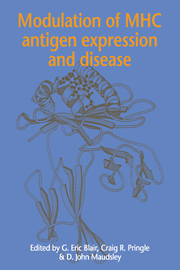Book contents
- Frontmatter
- Contents
- List of contributors
- Preface
- List of abbreviations
- 1 General introduction to the MHC
- 2 Organization of the MHC
- 3 Interactions of cytokines in the regulation of MHC class I and class II antigen expression
- 4 Control of MHC class I gene expression
- 5 Control of MHC class II gene expression
- 6 Modulation of MHC antigen expression by viruses
- 7 Modulation of MHC antigen expression by retroviruses
- 8 Modulation of MHC class I antigen expression in adenovirus infection and transformation
- 9 MHC expression in HPV-associated cervical cancer
- 10 Inhibition of the cellular response to interferon by hepatitis B virus polymerase
- 11 Cellular adhesion molecules and MHC antigens in cells infected with Epstein-Barr virus: implications for immune recognition
- 12 Effect of human cytomegalovirus infection on the expression of MHC class I antigens and adhesion molecules: potential role in immune evasion and immunopathology
- 13 Oncogenes and MHC class I expression
- 14 Mechanisms of tumour cell killing and the role of MHC antigens in experimental model systems
- 15 Manipulation of MHC antigens by gene transfection and cytokine stimulation: a possible approach for pre-selection of suitable patients for cytokine therapy
- 16 Overexpression of MHC proteins in pancreatic islets: a link between cytokines, viruses, the breach of tolerance and insulindependent diabetes mellitus?
- 17 The role of cytokines in contributing to MHC antigen expression in rheumatoid arthritis
- 18 Expression of an MHC antigen in the central nervous system: an animal model for demyelinating diseases
- Index
18 - Expression of an MHC antigen in the central nervous system: an animal model for demyelinating diseases
Published online by Cambridge University Press: 11 September 2009
- Frontmatter
- Contents
- List of contributors
- Preface
- List of abbreviations
- 1 General introduction to the MHC
- 2 Organization of the MHC
- 3 Interactions of cytokines in the regulation of MHC class I and class II antigen expression
- 4 Control of MHC class I gene expression
- 5 Control of MHC class II gene expression
- 6 Modulation of MHC antigen expression by viruses
- 7 Modulation of MHC antigen expression by retroviruses
- 8 Modulation of MHC class I antigen expression in adenovirus infection and transformation
- 9 MHC expression in HPV-associated cervical cancer
- 10 Inhibition of the cellular response to interferon by hepatitis B virus polymerase
- 11 Cellular adhesion molecules and MHC antigens in cells infected with Epstein-Barr virus: implications for immune recognition
- 12 Effect of human cytomegalovirus infection on the expression of MHC class I antigens and adhesion molecules: potential role in immune evasion and immunopathology
- 13 Oncogenes and MHC class I expression
- 14 Mechanisms of tumour cell killing and the role of MHC antigens in experimental model systems
- 15 Manipulation of MHC antigens by gene transfection and cytokine stimulation: a possible approach for pre-selection of suitable patients for cytokine therapy
- 16 Overexpression of MHC proteins in pancreatic islets: a link between cytokines, viruses, the breach of tolerance and insulindependent diabetes mellitus?
- 17 The role of cytokines in contributing to MHC antigen expression in rheumatoid arthritis
- 18 Expression of an MHC antigen in the central nervous system: an animal model for demyelinating diseases
- Index
Summary
Introduction
Demyelinating disorders of the CNS, while bound together by a common process involving damage to or improper laying-down of the myelin sheath, do not share a common aetiology. This is demonstrated by recent advances, which have enabled the classification of these conditions into three groups based on disease aetiology: genetic, viral and autoimmune.
Pelizaeus–Merzbacher disease exemplifies the genetic component of certain demyelination conditions. This X-linked recessive disorder affecting CNS myelination in children is attributed to deficient biosynthesis of the proteolipid protein (PLP) (Koeppen et al., 1987). Lack of PLP, one of the most abundant components of the myelin sheath, contributes to physical symptoms such as spastic extremities and lack of purposeful movement and head control.
The viral aetiology of demyelinating diseases is seen in progressive multifocal leukoencephalopathy (PML). Originally described as a complication of leukaemia and Hodgkin's disease (Aström, Mancall & Richardson, 1958), PML develops mostly in immunocompromised patients with chronic diseases and, more recently, in individuals with AIDS (Levy, Bredsen & Rosenblum, 1985; Niedt & Schinelle, 1985). Symptoms in PML reflect the widespread destruction of the CNS white matter. Neurological deficits include dementia, confusion, aphasia, hemiparesis and ataxia. The viral aetiology of PML has been demonstrated by isolation of the papovavirus JC from the brains of diseased patients (Padgett et al., 1971) and by the demonstration that transgenic mice with part of the JC viral genome develop a neurological disorder that involves dysmyelination of the CNS (Small et al., 1986; Feigenbaum, Hinrichs & Jay, 1992).
Information
- Type
- Chapter
- Information
- Modulation of MHC Antigen Expression and Disease , pp. 409 - 423Publisher: Cambridge University PressPrint publication year: 1995
